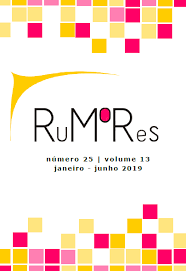Hypermediation and interactivity
for a documentary critique as a multi-media space
DOI:
https://doi.org/10.11606/issn.1982-677X.rum.2019.153379Keywords:
Documentary 3.0, interface, interactivityAbstract
The documental genre is older than the cinema, having emerged in journalistic narratives and in publishing illustrations. With the advent of photography and cinema, the documentary acquired consistency and a proper syntax, considering methodologies and complexities present in the 20th century. Nowadays, it has been changing based on the web space and the digital environment as they offer new tools and possibilities for both creators and audiences. This paper considers the documentary not only as a cinema genre strictly, but essentially as multi-media. Considering the specificities of audiovisual documentaries, it is possible to think of their transition and complementarity firstly on the cinema and then on television. Both dialogue with the specificities of their own media and with the innovation they have brought, corresponding subgenres and possible remixes.
Downloads
References
BARNOUW, E. El documental: historia y estilo. Barcelona: Gedisa, 1993.
BEIGUELMAN, G. O livro depois do livro. São Paulo: Peirópolis, 2003.
BENJAMIN, W. Obras escolhidas: magia e técnica, arte e política. São Paulo: Brasiliense, 1994.
BOLTER, J. D.; GRUSIN, R. Remediation: understanding new media. Cambridge, MA: MIT Press, 2000.
BRAGA, E. A interatividade e a construção do sentido no ciberespaço. In: LEÃO, L. (Org.). O chip e o caleidoscópio: reflexões sobre as novas mídias. São Paulo: Ed. Senac, 2005. p. 123-131.
COUCHOT, E. A arte pode ainda ser um relógio que adianta? O autor, a obra e o espectador na hora do tempo real. In: DOMINGUES, Diana (Org.). A arte no século XXI: a humanização das tecnologias. São Paulo: Ed. Unesp, 1997. p. 135-143.
COUCHOT, E. A tecnologia na arte: da fotografia à realidade virtual. Porto Alegre: Ed. UFRGS, 2003.
DA-RIN, S. Espelho Partido: tradição e transformação no documentário. Rio de Janeiro: Azougue, 2004.
FLUSSER, V. O mundo codificado: por uma filosofia do design e da comunicação. São Paulo: Cosac Naify, 2007.
LUNENFELD, P. Os mitos do cinema interativo. In: LEÃO, Lucia (Org.). O chip e o caleidoscópio: reflexões sobre as novas mídias. São Paulo: Ed. Senac, 2005. p. 365-383.
MANOVICH, L. The language of new media. Cambridge, MA: MIT Press, 2001.
MUANIS, F. O pintor, o montador, o cineasta e seu amante. Sessões do Imaginário, Porto Alegre, ano 12, n. 17, p. 24-34, 2007.
NICHOLS, B. Introdução ao documentário. Campinas: Papirus, 2005.
PENAFRIA, M. O filme documentário: história, identidade, tecnologia. Lisboa: Cosmos, 1999.
PRISON Valley: the prison industry. Direção: Philippe Brault e David Dufresne. Produção: Alexandre Brachet, Gregory Trowbridge. Estrasburgo: Arte, 2010. 1 vídeo (100 min). Disponível em: https://bit.ly/2q9YX4V. Acesso em: 26 jun. 2017.
SANTAELLA, L.; NÖTH, W. Imagem: cognição, semiótica, mídia. São Paulo: Iluminuras, 2008.
SOMMERER, C.; MIGNONNEAU, L. Cultural interfaces: interaction revisited. In: GRAU, O. (Org.). Imagery in the 21st century. Cambridge, MA: MIT Press, 2013.
YOUNGBLOOD, G. Expanded cinema. Nova Iorque: Dutton, 1970.
WALKING the Edit. Genebra: Ulrich Fischer, 2011. Disponível em https://bit.ly/2GlqQPy. Acesso em: 9 mar. 2017.
Downloads
Published
Issue
Section
License
Declaro a total e irrestrita cessão de direitos autorais sobre o texto enviado para publicação na Rumores – Revista Online de Comunicação, Linguagem e Mídias. Entendo que o conteúdo do artigo é de minha inteira responsabilidade, inclusive cabendo a mim a apresentação de permissão para uso de imagens, ilustrações, tabelas, gráficos de terceiros que, porventura, venham a integrá-lo.









